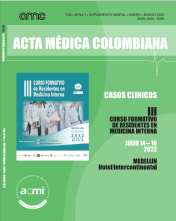Esosinophilic duodenitis associated with food allergy, debuting as acute visceral pain in an adult with vitiligo
Abstract
Introduction: the prevalence of eosinophilic duodenitis ranges from 5.1 to 8.2 per 100,000 people. The underlying molecular mechanisms are unknown, but hypersensitivity (seasonal and food allergies) play an important role in its pathogenesis, with allergic predisposition found in 25-35% of cases. The diagnosis includes clinical signs and symptoms, imaging findings and histological evidence of eosinophilic infiltration with >20 eosinophils per high-power field.
Case information: a 25-year-old man with vitiligo presented to the emergency room with acute visceral pain, dyspepsia and feeding intolerance, with normal laboratory tests except for an eosinophil count >2,000 cells/ mm3. An upper endoscopy showed erythematous pangastritis and duodenitis with rigid, thickened folds. Serial stool tests were negative for parasites. Total IgE, IgA and IgG were within normal limits, with a negative autoimmunity profile. In the following four days, the abdominal pain increased along with the eosinophil count, with a follow-up endoscopy and abdominal-pelvic tomography with contrast showing an edematous duodenum with severe bile reflux. Histopathology reported chronic atrophic duodenitis, and he had positive food allergy tests. A restrictive diet was ordered along with a proton pump inhibitor (pantoprazole). Outpatient follow-up 45 days later showed symptom resolution and a normal eosinophil count.
Conclusion: we present a case of eosinophilic duodenitis related to food allergies in a young man with vitiligo who debuted with an unusual clinical picture of acute visceral pain and bile reflux which resolved with an elimination diet and pantoprazole, without corticosteroids
Metrics
Acta Medica Colombiana uses the CC-BY 4.0 license. Authors retain all rights over their work.


